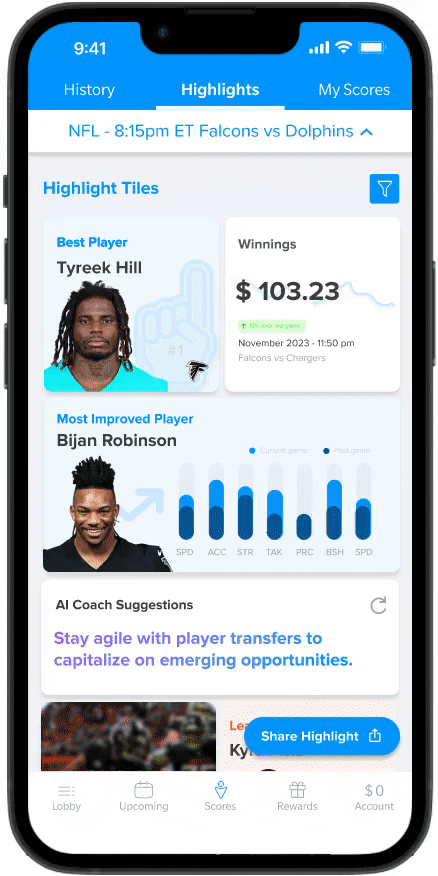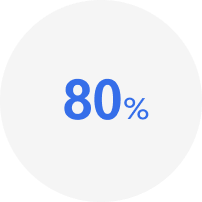
Industry Sponsored - FanDuel
Fall 2023
Aaron Gabryluk, Alice Gao, Cassia Tang, Meera Bharat, Viswak Raja





FanDuel specializes in mobile sports betting in multiple states across the United States, and have two major products: FanDuel Sportsbook and the Fantasy app. They, partnered with team RGB-GT, and are now looking into how they will be able to utilize generative AI to improve the user experience on the Fantasy app. Our team has been tasked with conducting user research to determine how fantasy players are utilizing AI to improve their experience and how to integrate this into their infrastructure. Furthermore, FanDuel has expressed their interest in setting themselves apart from their competitors by using AI to provide strategic advantage to their players and create a more personalized experience than their competitors can provide.
An evidence-based design study and exploratory research on the use of AI assistants primarily aiding new players on Fanduel's Fantasy football application.
Based on our research we found that amateur users would usually have to their own research on the players they choose for their roster and rely on friends to create and learn how to make decisions while playing Fantasy sports. This would mean the user would have to rely on other sources of information outside the application and evaluate on how these info would effect their decisions
The feature we are adding would aid in the initial steps of user experience and aid the user in getting verified information on the app. Additionally we wanted to provide a quick highlight of the performance and of the football game with insights on how they can improve in their upcoming games. The user can also choose to share their highlights on social media to share their achievements and encourage their other members in their team
I was actively involved in user research, conducting interviews to gather insights directly from our target audience. Additionally, I was responsible for the product design, I created wireframes and prototyoes to showcase functionalities, Additionally I created a design system for the final design iterations
The Highlight page gives a summary of all the highlights of the user’s most recent game. It also provides AI suggestions for improvement that can help users strategize better for their next fantasy games.

The highlights can be shared either as a video reel based on user preference. The user can share these on any social platform or choose to save it on their device.

The highlights can be shared also as a report. The user can share these on any social platform or choose to save it on their device.

This feature provides a way for the user to get summary of highlights from their past games. The user can select games from the history tab and create a highlight.

Users can edit the visual style and the content of the highlight video. The user has the option to decide the style from the given options, that changes seasonally and also use AI prompt to describe how they want the video to be generated.



FanDuel has 12 million registered users

In United states, FanDuel’s Fantasy app is operating in 44 states

In 2022, AI- powered sports betting platforms boasted an accuracy rate of over 80%

Utilization of AI in the sports industry will reach a value of 19.2 billion dollars by 2030.
The global fantasy sports market size was estimated at USD 20.30 billion in 2022 and is expected to grow at a CAGR of 14.1% from 2023 to 2030.

Despite the 2023 generative AI boom, development has been in progress for decades prior. Generative AI has been used for menial tasks such as spam detection and auto-complete for decades, but has now found itself being able to generate full text, code, art, logos, and even 3D models.

Sources:
https://www.lexology.com/library/detail.aspx?g=d167a21f-57cf-4a9a-b8e7-612c220b2e94,
https://www.alliedmarketresearch.com/artificial-intelligence-in-sports-market-A12905
The primary target users are Daily Fantasy Sports(DFS) players. The DFS players can further be characterized as the following:




Analyze how current fantasy sports users use their DFS applications, identify which features they value, and uncover relevant motivations, attitudes and behaviors.
We covered 4 main sections, each focused on different aspects of the user experience in fantasy sports, especially for app use.
We conducted 5 interviews with Fantasy sport players and used Dedoose to open code the transcripts. A few key findings are listed below:
Survey was distributed among people who have experience playing fantasy sports. The structure of the questions were as follows
General Information
Generative AI for Customization
Generative AI for Drafting.
We received 31 responses and for analysis we used Qualtric’s built-in analysis system for quantitative data and coding for open-ended questions. A few key findings are listed below:
Generative AI to Assist Drafting (two clusters):
Generative AI for Customization:
Survey was distributed among people who have heard of or used Generative AI. The structure of the questions were as follows
For participants who have heard of generative AI and ever used it:
For Participants Who Have Used Generative AI
We received 22 responses and for analysis we used Qualtric’s built-in analysis system for quantitative data and coding for open-ended questions. A few key findings are listed below:
Communication Preferences:
Comfortableness and Trust:
The goal is to systematically analyze and evaluate the user interface, functionality and identify areas of improvement in the process of creating and playing a Fantasy sports league. The breakdown can help to pinpoint on issues and ensure that the app aligns with the user’s expectations.
The goal is to identify where FanDuel stands in comparison with its competitors and to also identify potential gaps where the user experience can be improved with respect to the use of generative AI.
To understand where any pain points may be withing the core process of using Fanduel
Based on our insights and observations from the research methods, we created a persona that captured the essence of our users and their characteristics.

Based on our insights and observations from the research methods, we derived design implications that will help us inform our design iteration in the next phase.

As a team we brainstormed on different concepts based on our initial design implications. Our purpose was to ideate different methods of introducing generative AI to assist using users in driving decision and improving their experience in the FanDuel DFS app.
Gain insights on our 6 sketched design ideas from a user's perspective and pick 3 best ones.
To refine our designs, ensure they align with FanDuel’s objectives, and pick the final idea.


Lorem ipsum dolor sit amet, consectetur adipiscing elit. Suspendisse varius enim in eros elementum tristique. Duis cursus, mi quis viverra ornare, eros dolor interdum nulla, ut commodo diam libero vitae erat. Aenean faucibus nibh et justo cursus id rutrum lorem imperdiet. Nunc ut sem vitae risus tristique posuere.
Lorem ipsum dolor sit amet, consectetur adipiscing elit. Suspendisse varius enim in eros elementum tristique. Duis cursus, mi quis viverra ornare, eros dolor interdum nulla, ut commodo diam libero vitae erat. Aenean faucibus nibh et justo cursus id rutrum lorem imperdiet. Nunc ut sem vitae risus tristique posuere.



To refine and delve into the intricacies of the final concept wireframe.
Three sessions were performed: 2 focus group sessions of 4 participants each, 1 individual interview.
Questions were framed to understand the overall usability and functions of certain elements of the design:
From the notes taken during feedback session, we conducted an interpretation session to synthesize user’s feedback. Then we extracted key findings and specific design implications from their suggestions
We created a design system based out of Fanduel’s app to make our wireframe more coherent to the existing application
Experts were asked to evaluate our prototype based on 8 metrics. Each metric contained anywhere between 4 and 22 questions associated with it, Each on a 5 point scale.
To evaluate this prototype, we conducted a remote un-moderated task-based usability study with Fantasy sport players spanning across different demographics and expertise level. This was followed by a qualitatitve survey that asked participants to describe their thought process while performing the tasks.
Here's a brief overview of the process:
Post task
+ Positive
- To Improve
Word Choice
+ Positive
- Negative
SUS
This was my first project since I began my Master's in HCI at Georgia Tech. It was a great learning experience working with my fellow classmates, all of whom come from varied backgrounds and complement each other's skill set. Being able to work with an industry partner definitely made the entire thing much more realistic than a traditional 'no-constraints' class project.
Lorem ipsum dolor sit amet, consectetur adipiscing elit. Suspendisse varius enim in eros elementum tristique. Duis cursus, mi quis viverra ornare, eros dolor interdum nulla, ut commodo diam libero vitae erat. Aenean faucibus nibh et justo cursus id rutrum lorem imperdiet. Nunc ut sem vitae risus tristique posuere.